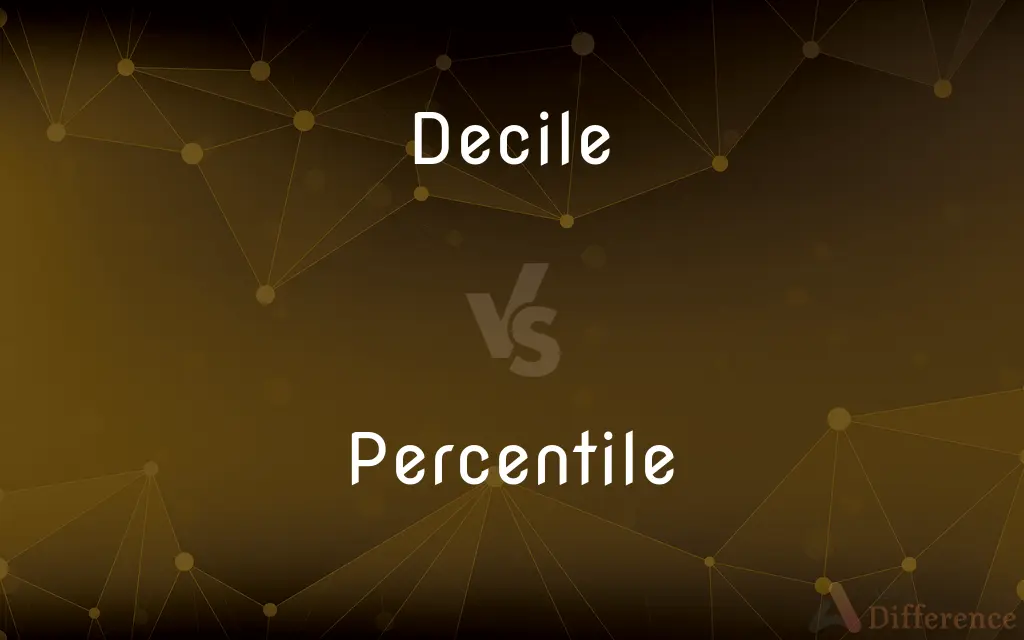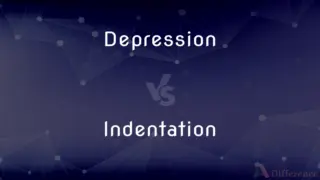Decile vs. Percentile — What's the Difference?
By Fiza Rafique & Maham Liaqat — Updated on April 5, 2024
Deciles divide a dataset into ten equal parts, while percentiles split it into 100 equal sections.

Difference Between Decile and Percentile
Table of Contents
ADVERTISEMENT
Key Differences
Deciles are statistical measures that divide a dataset into ten equal parts, with each part representing 10% of the distributed data. This means that the first decile separates the lowest 10% of data from the top 90%, the second decile the lowest 20% from the top 80%, and so on. Percentiles, on the other hand, split the data into 100 equal sections, making each percentile represent 1% of the dataset. Thus, the 25th percentile marks the point below which 25% of the data falls, and the 75th percentile the point below which 75% of the data falls.
While deciles provide a broader overview of data distribution and are used to categorize data into ten groups for easier analysis and comparison, percentiles offer a more detailed view, allowing for finer distinctions among data points. For example, the median of a dataset is equivalent to the 50th percentile, also falling between the fifth and sixth deciles.
Deciles are particularly useful in fields like economics and education to identify income quintiles or performance levels, whereas percentiles are widely used in standardized testing and health metrics to compare individual scores or measurements to a broader population. For instance, being in the 90th percentile on a test means scoring better than 90% of participants.
The use of deciles can simplify data analysis by reducing the dataset into more manageable parts, making it easier to identify trends and outliers. Percentiles, with their greater specificity, are helpful in settings where precise distinctions are necessary, such as determining eligibility for programs or interventions based on exact rankings within a population.
Both deciles and percentiles are tools for understanding the distribution and variance within datasets, but they cater to different analytical needs. Deciles offer a macro view, useful for segmenting data into broad categories, while percentiles provide a micro view, essential for detailed comparisons and specific decision-making processes.
ADVERTISEMENT
Comparison Chart
Division
Divides data into 10 equal parts
Divides data into 100 equal parts
Purpose
Categorization and broader analysis
Detailed analysis and specific comparisons
Example Usage
Identifying income quintiles in economics
Ranking students' test scores in education
Data Representation
Each part represents 10% of the dataset
Each part represents 1% of the dataset
Specificity
Less detailed, broader view
More detailed, finer distinctions
Compare with Definitions
Decile
Segregating student performance levels.
Students in the first decile qualify for advanced programs.
Percentile
Detailed employee ranking.
Employees in the 90th percentile received higher bonuses.
Decile
Understanding consumer distribution.
The bottom decile may be targeted for discount offers.
Percentile
Ranking individual scores.
The 75th percentile score was 1800 on the SAT.
Decile
Used for income distribution analysis.
The top decile holds more than half of the nation's wealth.
Percentile
Assessing child development.
Being in the 40th percentile for height at a certain age.
Decile
Dividing data for trend analysis.
Sales data divided into deciles to identify buying patterns.
Percentile
Precise data segmentation.
Analyzing customer satisfaction scores by percentile.
Decile
A statistical measure dividing data into ten equal parts.
The bottom decile of the class scored below 50% on the exam.
Percentile
Divides data into 100 equal sections, each representing 1%.
Scoring in the 95th percentile means outperforming 95% of peers.
Decile
In descriptive statistics, a decile is any of the nine values that divide the sorted data into ten equal parts, so that each part represents 1/10 of the sample or population. A decile is one possible form of a quantile; others include the quartile and percentile.
Percentile
In statistics, a percentile (or a centile) is a score below which a given percentage of scores in its frequency distribution falls (exclusive definition) or a score at or below which a given percentage falls (inclusive definition). For example, the 50th percentile (the median) is the score below which (exclusive) or at or below which (inclusive) 50% of the scores in the distribution may be found.
Decile
Any of the groups that result when a frequency distribution is divided into ten groups of equal size.
Percentile
Each of the 100 equal groups into which a population can be divided according to the distribution of values of a particular variable.
Decile
Any of the values that separate each of these groups.
Percentile
Any of the groups that result when a frequency distribution is divided into 100 groups of equal size.
Decile
(statistics) Any of the values in a series that divides the distribution of individuals in that series into ten groups of equal frequency.
Although few people scored high marks, everyone did quite well—the lowest decile was over 50%.
Percentile
Any of the values that separate each of these groups.
Decile
Any one of the ten subsets or groups so divided.
Our school is in the top decile for exam results.
Percentile
(statistics) Any of the ninety-nine points that divide an ordered distribution into one hundred parts, each containing one per cent of the population.
Decile
(astrology) An aspect or position of two planets when they are distant from each other a tenth part of the zodiac.
Percentile
(statistics) Any one of the hundred groups so divided.
He is highly intelligent – he has an IQ in the top percentile.
Decile
(statistics) any of nine points that divided a distribution of ranked scores into equal intervals where each interval contains one-tenth of the scores
Percentile
(statistics) any of the 99 numbered points that divide an ordered set of scores into 100 parts each of which contains one-hundredth of the total
Common Curiosities
Why choose deciles over percentiles for analysis?
Deciles are chosen for a broader analysis to categorize data into more manageable segments, especially when a detailed distinction is not critical.
What is an example of percentile usage?
Percentiles are often used in education to rank students' test scores, showing how a student scored relative to peers.
What is a decile?
A decile is a statistical measure that divides a dataset into ten equal parts, each representing 10% of the data points.
Can you give an example of when to use a decile?
Deciles are useful in economics to analyze income distribution across a population, categorizing households into ten groups based on income levels.
How is a percentile different from a decile?
A percentile divides a dataset into 100 equal sections, making each section represent 1% of the data points, providing a more detailed segmentation than deciles.
What does it mean to be in the 10th decile?
Being in the 10th decile means being in the top 10% of a dataset, based on the criterion being measured.
When are percentiles more useful than deciles?
Percentiles are more useful when precise data segmentation is necessary, such as in standardized testing or detailed market analysis.
How do you interpret being in the 25th percentile?
Being in the 25th percentile means 25% of the data points are below and 75% are above the value you are at, indicating a position in the lower quarter of the dataset.
Can deciles and percentiles be used together?
Yes, both can be used together for a comprehensive analysis, using deciles for broad categorization and percentiles for detailed comparison.
How do deciles and percentiles aid in data analysis?
They help in understanding the distribution and variance within datasets, facilitating targeted interventions and informed decision-making based on data segmentation.
Share Your Discovery

Previous Comparison
Depression vs. Indentation
Next Comparison
Boy vs. BuoyAuthor Spotlight
Written by
Fiza RafiqueFiza Rafique is a skilled content writer at AskDifference.com, where she meticulously refines and enhances written pieces. Drawing from her vast editorial expertise, Fiza ensures clarity, accuracy, and precision in every article. Passionate about language, she continually seeks to elevate the quality of content for readers worldwide.
Co-written by
Maham Liaqat















































